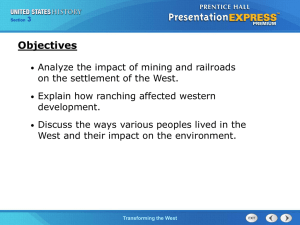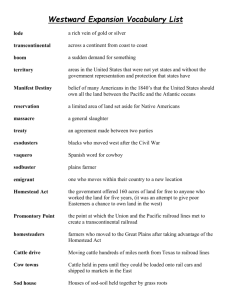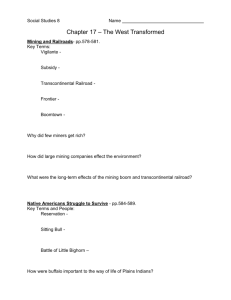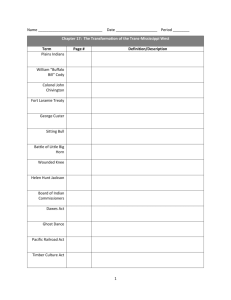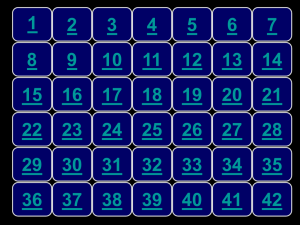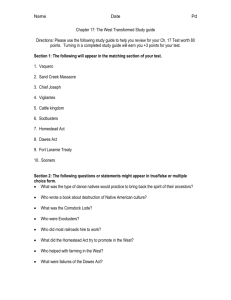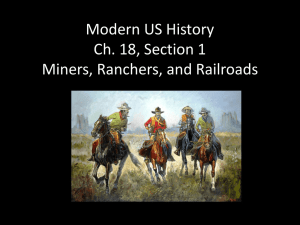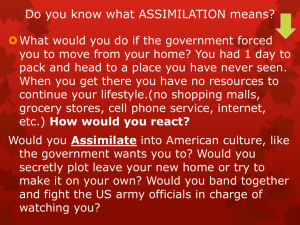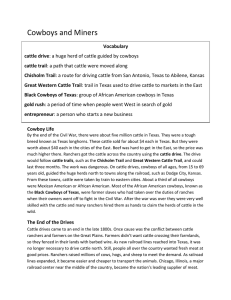6:3 PowerPoint - Copley
advertisement
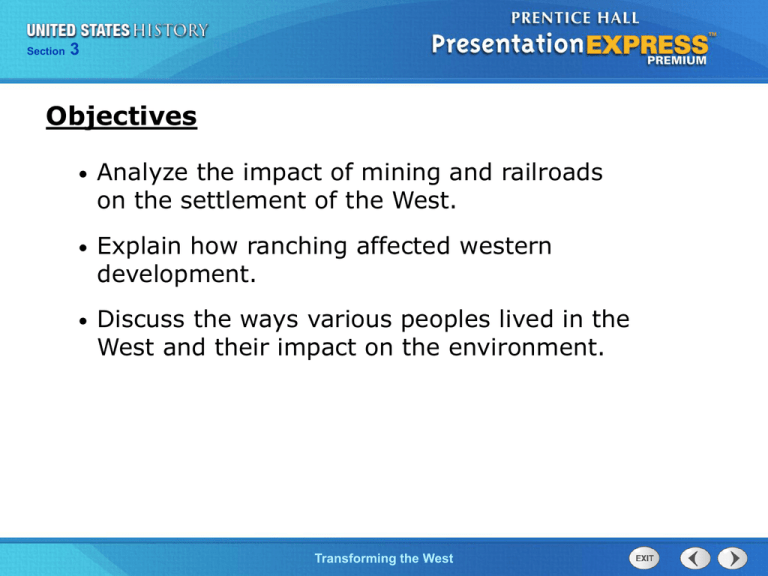
Chapter Section 25 Section 1 3 Objectives • Analyze the impact of mining and railroads on the settlement of the West. • Explain how ranching affected western development. • Discuss the ways various peoples lived in the West and their impact on the environment. The ColdTransforming War Begins the West Chapter Section 25 Section 1 3 Terms and People • vigilante – self-appointed law enforcer • transcontinental railroad – rail link between the eastern and western United States • land grant – land given by the federal government for building railroads • open-range system – system in which ranchers did not fence in their property, allowing cattle to roam and graze freely The ColdTransforming War Begins the West Chapter Section 25 Section 1 3 Terms and People (continued) • Homestead Act – 1862 law in which the government offered farm plots of 160 acres to anyone willing to live on the land for five years, dig a well, and build a road • Exodusters –African Americans who migrated from the South to the West after the Civil War The ColdTransforming War Begins the West Chapter Section 25 Section 1 3 What economic and social factors changed the West after the Civil War? In the late 1800s, miners, rail workers, ranchers, and farmers moved to the frontier in hopes of building better lives. The industrial and agricultural booms they created helped transform the West. The ColdTransforming War Begins the West Chapter Section 25 Section 1 3 The discovery of gold and silver created the first great boom in the West—mining. • • With each new find, prospectors rushed to the site, hoping to strike it rich. Others followed, bringing food and supplies. The ColdTransforming War Begins the West Mining camps quickly sprang up. Many camps grew into thriving communities. Chapter Section 25 Section 1 3 Because they had no judges or jails, miners often set their own rules for administering justice. • In the early days, vigilantes took the law into their own hands. • As towns grew, they hired marshals and sheriffs. Some towns, however, disappeared as quickly as they appeared. Boomtowns turned to ghost towns when the gold and silver ran out. The ColdTransforming War Begins the West Chapter Section 25 Section 1 3 Large companies soon took over the mining business from individual prospectors. • Could afford the heavy equipment needed to bring mineral ores out from deep underground • Were supported by the government with cheap land The ColdTransforming War Begins the West Chapter Section 25 Section 1 3 The railroads soon began work to fulfill a longtime goal—to build a transcontinental railroad linking the East and the West. As industries grew in the West, so did the need for railroads to transport goods and people. The government supported this goal through: • loans • land grants The ColdTransforming War Begins the West Chapter Section 25 Section 1 3 In 1863, the Central Pacific headed eastward from Sacramento. The Union Pacific headed westward from Omaha. They finally met at Promontory, Utah, in 1869. The ColdTransforming War Begins the West Chapter Section 25 Section 1 3 Work on the railroad had been difficult and dangerous. But it brought tremendous changes to the country. • Tied the nation together • Moved products and people • Spurred industrial development • Stimulated the growth of towns and cities • Encouraged settlers to continue to move west The ColdTransforming War Begins the West Chapter Section 25 Section 1 3 The railroad boom encouraged another western boom—the cattle boom. For years, ranchers had used an openrange system for raising livestock. • Property not fenced in • Cattle were branded, then grazed freely • Cowboys rounded up the cattle each spring The ColdTransforming War Begins the West Chapter Section 25 Section 1 3 Cowboys then drove cattle north to the rail lines, so they could be transported to market. The long, hard cattle drives could last for months. They ended at railroad towns, called cow towns. The ColdTransforming War Begins the West Chapter Section 25 Section 1 3 By the mid-1880s, however, the cattle boom was coming to an end. Reasons the openrange system ended The invention of barbed wire made fencing cheap. The supply of beef exceeded demand and prices dropped. Extreme weather led to the death of herds. The ColdTransforming War Begins the West Chapter Section 25 Section 1 3 Like miners and ranchers, farmers also moved west, looking for a better life. Railroad companies encouraged pioneer settlement. So did the government. Under the 1862 Homestead Act, the government gave land to farmers willing to tend it. Easterners, Exodusters, and immigrants soon poured onto the Great Plains. The ColdTransforming War Begins the West Chapter Section 25 Section 1 3 Life on the Plains was difficult and lonely. With little wood available, homesteaders made houses from sod. Storms, droughts, and locusts ruined crops. The ColdTransforming War Begins the West Chapter Section 25 Section 1 3 New inventions and farming methods, however, made life easier. • Barbed wire • Stronger plow • Grain drill • Windmill • Dry-farming techniques The ColdTransforming War Begins the West Chapter Section 25 Section 1 3 For many Americans, the West was a place to build new lives. But it also was a place of conflict. Economic rivalries Social conflicts • Cattle destroyed crops • Sheep ruined grasses • Mining runoff polluted water • Control of resources disputed • Prejudice • Discrimination • Ethnic tensions The ColdTransforming War Begins the West Chapter Section 25 Section 1 3 The last land rush took place in 1889, when the government opened the Oklahoma Territory to homesteaders. “boomers” lined up to stake claims “sooners” sneaked in early to take the best ones The next year, the government declared there was no land left for homesteading. The frontier closed. The ColdTransforming War Begins the West
